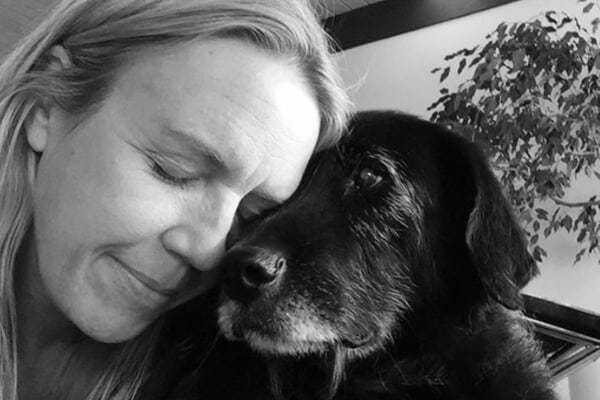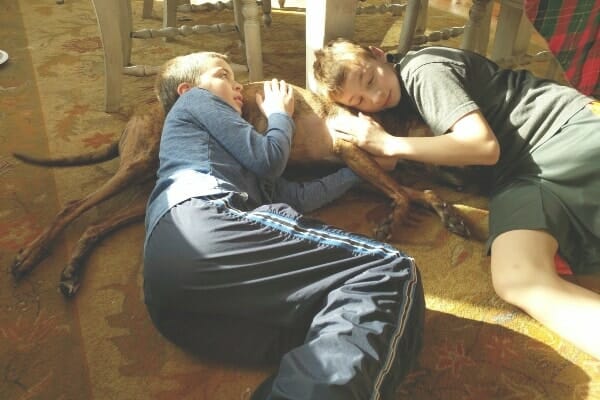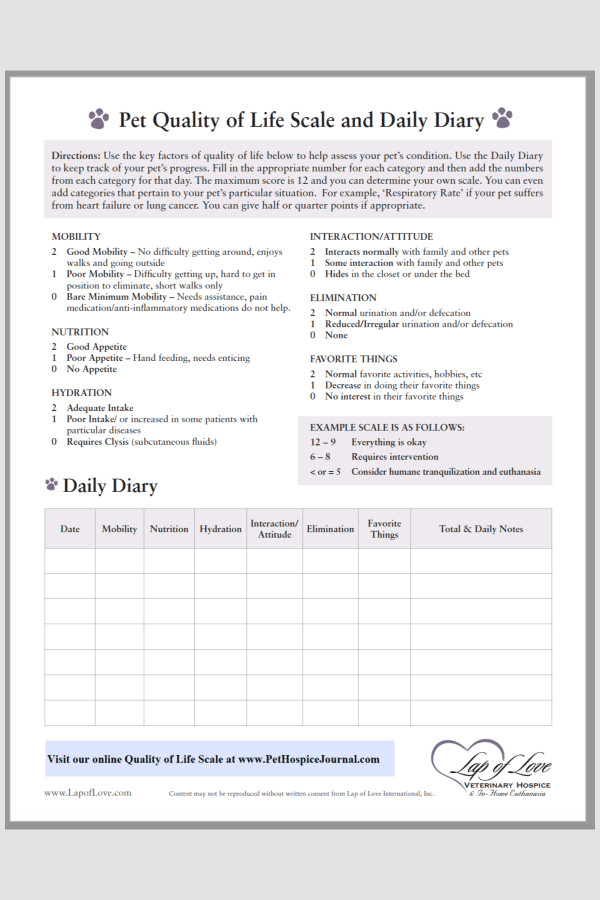Why Does My Blue Pits Neck Smell Like Poop

There are different shades of "difficult." But one of the darkest shades of difficult is anticipating the loss of a loved one. Our blog is dedicated to the empowerment of senior dog moms. But there's one topic we've never discussed because it's so difficult that it's almost unspeakable: signs your dog is dying. Consider this a trigger warning because I know this post will not be appreciated by everyone. But for some, it will be invaluable . . . and if that's you, please process these raw, honest words as a gift. I asked my friend and colleague, Dr. Amy Cottrille, to pen this piece. Dr. Cottrille is a house call veterinarian, dedicated to compassionate hospice care and home euthanasia for pets. Her words are wise. Although they may bring pain, ultimately, we publish this to help alleviate pain. ~ Dr. Julie Buzby, founder of ToeGrips® for senior dogs
Are you struggling to know when is the right time to say goodbye to your dog?
Your canine companion has been by your side through the joys and sorrows of life. He's been steadfast in his loyalty and love, and the thought of letting your grey-muzzled companion go seems unbearable.
Dogs are amazing friends and companions who bring play, joy, and laughter into our homes. But the sad reality of sharing our lives with dogs is knowing our time with them will not last forever.
One day you will recognize your dog is sick and pivot from play and laughter to providing comfort, care, and possibly even euthanasia to end his suffering.
Your canine companion cannot communicate in words his distress, fear, or pain, so it is up to you to recognize the early signs of dying in your dog. Your early observations can reduce the amount of time your beloved dog is in discomfort, and allow you to comfort him with medication, treatments, and, ultimately, a dignified euthanasia.
How to recognize the signs your dog is dying
Many of the symptoms discussed below are present in non-fatal illnesses, too. These issues can be treated if caught early. If you observe these symptoms, make an appointment to see your veterinarian as soon as possible.
Here are symptoms commonly seen in ailing or terminal dogs.
Cardiac or respiratory symptoms
In addition to heart diseases in dogs such as congestive heart failure or dilated or hypertrophic cardiomyopathy (DCM or HCM), dogs may have these symptoms from cancers that commonly spread to the lungs. These cancers include lymphoma in dogs, melanoma, osteosarcoma, aggressive mast cell tumors or hemangiosarcoma in dogs, or any disease that decreases red-blood-cell production (the cells that carry oxygen in the blood), such as bone marrow cancers or kidney disease.
- Lethargy. With a heart or lung disease, your dog will be tired (i.e. a lethargic dog). He may be unable to walk upstairs, cross a room without stopping, be unwilling to get up without a lot of coaxing (if at all), and urinate or defecate in his bed.
- Increased respiratory rate. Instead of taking a breath about every four seconds while resting or sleeping (15-20 breaths per minute), your dog may take shallow breaths every second or two (40-80+ breaths per minute). As mentioned, there are a variety of reasons a dog is breathing fast.
- Change in sleeping position or location. A dog who used to enjoy sleeping on his side may now prefer to sleep on his chest to make breathing easier. Your dog may extend his neck while sleeping, or drape it off the bed. He may also leave his bed to rest on a hard surface such as a rug or the floor. While some dogs have always exhibited these behaviors, for your dog, it may be new.
- Very restless. A dog who sleeps lightly, gets up frequently to pace the room, or moves to a new sleep location during the night may be ailing. As our sweet pups age, senior dog anxiety at night can definitely increase.
- Pale mucous membranes. A dog with a low red blood cell count may have pale pink-to-white gums instead of the normal dark pink. Immune mediated hemolytic anemia (IMHA in dogs), blood loss from splenic masses in dogs, and a variety of other conditions can lead to pale gums. (For more information on how to assess gum color, please read Dr. Buzby's post, Keeping a "Pulse" On Your Dog's Vital Signs.)
- Coughing. With many cancers or with heart failure, the lungs may begin to fill with fluid. This causes your dog to cough. The cough may be raspy or have a wet sound, as though he is trying to clear fluid with each cough.
- Panting. Your dog may pant to breathe in more oxygen or to cool his body down.
Gastrointestinal or abdominal symptoms
Organ failure, abdominal cancers, and diseases that affect the stomach or intestines, such as Addison's disease in dogs or Cushing's disease in dogs, may result in these tell-tale symptoms.
- Lack of appetite. When your food-loving dog stops eating or becomes super picky, he may be ill or terminal. Loss of appetite is a significant symptom not to be ignored.
- Dry heaving or vomiting. Vomiting blood is a bad sign, as is vomiting partially-digested food with a "coffee grounds" appearance.
- Nausea. While your dog may act interested in food, he turns away when you give it to him. This is a sure sign of nausea, as is an increase in drooling.
- Diarrhea. This is a common symptom of illness. Stool may be bloody or have a tar-like appearance. Tarry stool is usually an indication of bleeding higher in the GI tract, instead of in the colon.
- Constipation. Tumors that block the intestines or colon, or diseases that prevent the intestines from normal movement cause constipation. In some conditions, this becomes painful very quickly.
- Abdominal swelling. When your dog is standing or lying on his side, you may see swelling in his abdomen. This may make walking or lying down uncomfortable.
- Pain. Signs your dog is in pain are very common in end-stage abdominal disease when your dog moves or when you apply pressure to his stomach.
This cluster of symptoms is caused by primary brain tumors, inflammation of the tissues surrounding the brain, cancers that may spread to the brain or cause pressure on the brain (such as cancers of the jaw or skull), or seizures in dogs from different organ system diseases (such as liver disease in dogs).

- Extreme behavioral changes. Aggression, fear, confusion, or disorientation from your dog, who was fine yesterday, can signify a medical condition.
- Sudden loss of vision, hearing, or changes in coordination. Stumbling, circling, or falling are all signs that point to a mental or brain-related condition.
- Seizures. Seizures are frequent in ailing dogs. The first two seizures may be hours apart, with subsequent ones occurring closer together and lasting longer.
- Decrease in mental awareness. If your dog is experiencing seizures, he may go from being very distressed and agitated after the first seizure to not recognizing loved ones or realizing another person or animal is in the room after subsequent seizures.
Nonspecific signs that your dog may be dying
While some symptoms mentioned above are clear indicators of a specific disease, other symptoms are nonspecific but provide clear evidence your dog is not well.
- Hiding behavior. If you observe your dog crawling under bushes or decks outside or hiding under or behind furniture inside, take note. Your dog instinctively knows an ill animal in the wild is at risk of being hunted by a predator, so pay attention to hiding behavior.
- Avoidance behavior. If your otherwise friendly dog begins to avoid people, petting, and attention, it's a clear sign something is wrong.
- Involuntary muscle twitching or spasms. Spasms or twitches are common and are possibly caused by electrolyte imbalances due to a lack of eating nutrients.
- Bleeding. Any bleeding, especially from the nose or anus, is of serious concern.
- Swelling of the throat or legs. You can test for swelling by applying pressure to your dog's skin with your thumb. If the tissue is slow to recover, the area is swollen.
- Pain. If your dog is experiencing pain, he may hunch, pant, shake, cry, whine, whimper, or groan. He may also growl or bite when approached or squint his eyes.
- Body temperature changes. A dog with a fever may seek a cool floor surface to lie on. In some cases, changes in your dog's body temperature may be detectable when petting his ears, legs, or feet.
- Excessively drinking water. Many dogs will drink water until just before death and some will even show increased thirst in dogs. Don't assume your dog is well because he is still drinking. Evaluate other signs and behaviors for a more accurate assessment.
What to do if you notice signs your dog is dying
If you see any of these symptoms in your senior dog, make an appointment with your veterinarian immediately. Jot down as much information as you can about your observations: the date, time, frequency, and circumstances. This will help your veterinarian provide the clearest answers and best treatment options for your dog.
If your family wishes for end-of-life care in the home, early recognition of a terminal illness will give you the best opportunity to make arrangements for a peaceful goodbye, where everyone in the family can be present if they wish.

We know how heartbreaking it is to watch your family member age and decline. We have been where you are, and know with a little awareness and a lot of love, you can be the best caretaker of your beloved dog no matter what challenge you're facing.
Help for you and your dog during this difficult time
End-of-life care and recognizing the signs your dog is dying is a heartbreaking subject. If you're anticipating the loss of your beloved dog, my heart goes out to you. By sharing the list of resources below, I hope to help you navigate this challenging time.
Additional reading
For more articles related to caring for your senior dog at the end of his or her life, please read:
- Saying Goodbye to Our Dog
- Dog Euthanasia: Knowing When to Say Goodbye.
- In-Home Dog Euthanasia: Heartfelt Answers to 12 FAQs
- Dog Hospice Care Can Bring Peace and Dignity to Your Dog's Final Days
- Preparing for Your Dog's Euthanasia: 10 Thoughts for Peace
- Grieving the Loss of a Dog After Euthanasia (& Finding Peace)
Quality of life scale and in-home euthanasia services
To find an in-home pet euthanasia service near you, please visit the Association of Pet Loss and Bereavement website. In addition to offering a U.S. directory of in-home euthanasia services, they also offer pet bereavement support.
Finally, Lap of Love Veterinary Hospice and In-Home Euthanasia offers compassionate end-of-life care. I hold this organization in high regard for providing veterinary hospice care and in-home euthanasia services throughout the United States. Additionally, their pet quality of life scale can help you assess your dog's condition. They have graciously permitted us to share the Lap of Love Pet Quality of Life Scale and Daily Diary (below) with our readers.

Are you struggling with end-of-life care for your dog?
Please comment below. Our community is here to offer you comfort and support during this difficult time.
williamscondets1989.blogspot.com
Source: https://toegrips.com/signs-your-dog-is-dying/
0 Response to "Why Does My Blue Pits Neck Smell Like Poop"
Enregistrer un commentaire